Shelf 4 - Stereo Photography
©opyright by James Ollinger. All rights reserved.
Contents:
|
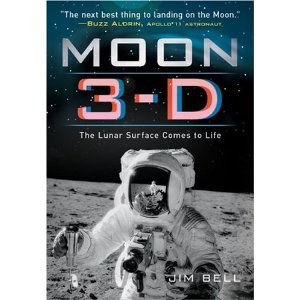
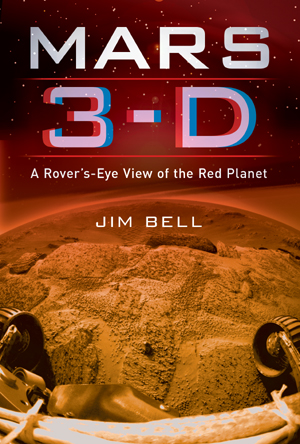
Jim Bell:Mars in 3-D and Moon in 3-D
It doesn't get mentioned much but the astronauts took stereo photos on the moon; they are simply printed as singles. The mars rovers do the same.
These two books attempt to make the 3-D images available by offering both sides. Unfortunately for me, they did it in differently than most.
Set up like the Mark Blum nature books below, there's a viewer bound into the inside cover and the photos are set so that if you look through the viewer, the photos are the right distance to be properly viewed. This means that there's no viewer to lose and everything stays together.
Unlike the Blum books, which present stereo pairs, Bell's books use anaglyphs: that's where the pairs are printed superimposed (one on top of the other); the left side is printed in blue and the right side is printed in red. The viewer lenses are also red and blue (but with the positions reversed) so that the left eye sees only the blue image and the right eye sees only the red.
In theory it's a great idea but in practice it's far less effective than using stereo pairs. First off, the printing and the filters have to be really good in order to work properly, and that's a tough requirement for something mass-produced and inexpensive like this book. Second, red and blue will screw up the natural colors no matter what. For a subject like the moon, which is gray, that isn't a problem; on Mars (which is predominantly red) it's more challenging.
The third, and most important, is that if you're color blind, then anaglyphs don't work. Red-blue color-blindness is typical in men; even though true color-blindness doesn't show up that often (but my grandfather was, absolutely), color-weakness to some extent or another is very common. I can see the full range of colors but I'm weak in certain areas; if the colors aren't saturated very well (I have trouble matching socks) or small (I can't tell a green LED from a red LED on a telephone base unless I'm right next to it), then colors become indistinct.
So I have a lot of trouble with these books. In bright light I can kind of make Moon work, but I can't do anything with Mars no-way no how.
I believe they printed anaglyphs for a good reason: by printing one image on a single page, rather than a pair, they got one large image instead of two smaller ones. That's fine, but then close-focus also becomes a problem; if you're older and you have trouble with close focus, these images are going to be blurry. I have bifocals and I still struggle. The only way I make it work is to look at the book under bright sunlight.
An A for effort and intent, but an F in execution—for me anyway. Your mileage may vary.
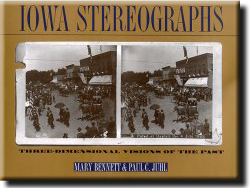
Mary Bennett & Paul C. Juhl: Iowa Stereographs
I have no desire to go to Iowa. I've never been there and I probably never will. But this is one of my favorite books of stereo views. The authors collected all kinds of views of Iowa and produced them full-size, in pairs (along with a little viewer), in this wonderful book. Images are both rural and urban, interiors and exteriors, and people and places. In addition to the many views there are lots of comments, commentary and quotes. It's partly a book about Iowa, partly about stereo photography, mainly about a time gone on both sides of the lens.
I wish there were a lot more books like this one. In fact there is! See Indiana in Stereo below.
Mark Blum: Amphibians & Reptiles in 3-D, Beneath the Sea in 3-D, Bugs in 3-D and Galapagos in 3-D
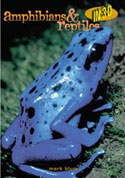 |
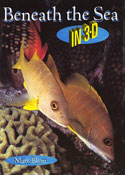 |
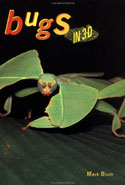 |
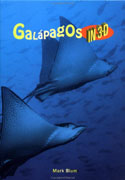 |
Mark Blum is a photographer and naturalist who combined his interests in nature and stereo-photography to create these wonderful children's books. Stereo photos are three-dimensional when viewed with an appropriate viewer. In most books this would be a pair of glasses that easily get lost. These books use a better approach: the glasses are permanently mounted a foldout leaf on the front cover; the stereo pairs are printed lengthwise along the page, so that the viewer and the page opposite are parallel and at the right distance for viewing. Because the glasses are permanently bound into the cover they can't (easily) be lost, which makes the book kid-safe.
most books this would be a pair of glasses that easily get lost. These books use a better approach: the glasses are permanently mounted a foldout leaf on the front cover; the stereo pairs are printed lengthwise along the page, so that the viewer and the page opposite are parallel and at the right distance for viewing. Because the glasses are permanently bound into the cover they can't (easily) be lost, which makes the book kid-safe.
They're marketed (and shelved in libraries) as kids' books, but I think adults would like them as well. The photographs are great—Blum knows the secret of good 3-D is separation—i.e. things that are close up enough that you get a real sense of depth and separation. These critters are all close, colorful, and beautifully presented. The 3-D effect is gravy—these photos would look great as singles too.
Each pair is about the critter pictured, and presented on the facing page so you can just tilt the book up and read about whatever you happen to be look at. I don't think the writing works that well for a casual audience, especially children because of the scientific vocabulary: these varmints generally don't eat, they feed; so that the book reads a lot like those dreary nature movies we all hazily remember from junior high school.
But the photos make up for everything. And they're attractractively priced. Cover is $18.95, but I see used editions routinely priced in the $6-$10 range. If you like stereo photographs, or if you like some really cool photos of animals, or if you just like a novelty—take a look at one Mark Blum's books (he has more than I've mentioned here)—they're worth it.
Mark Blum: Big Trucks and Diggers in 3-D and Coral Reef in 3-D

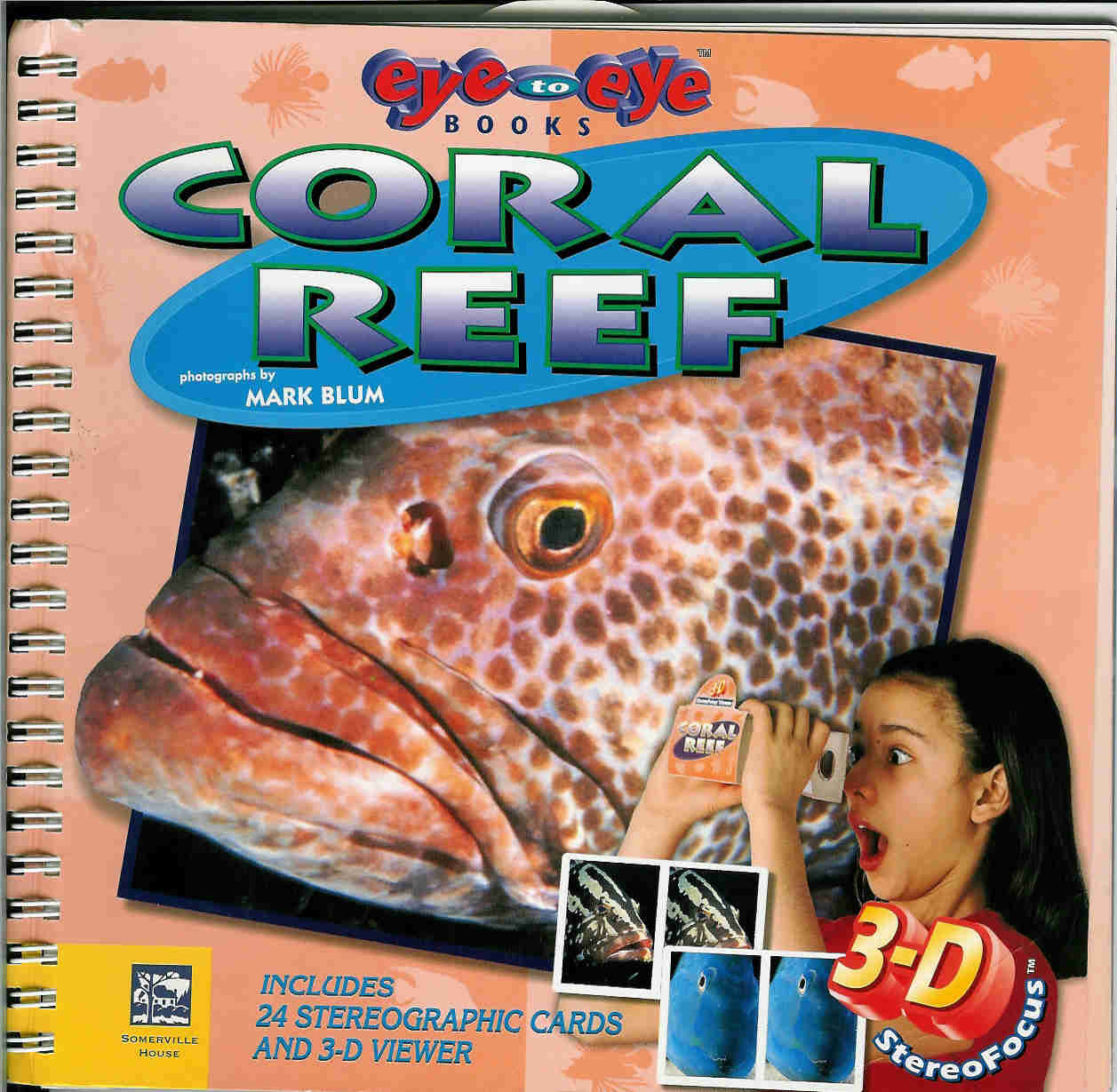
I listed these two Mark Blum books separately because they're a bit different from those above.
Big Trucks is the same format (viewer in the cover) as the nature books above, but concentrates on heavy equipment. The photos are almost all in landscape format (longer horizontally than vertically) so the images are smaller. The book is aimed at children (pre-teens) who are interested in these heavy vehicles.
Coral Reef is similar in content to his other nature books, but the 3-D part is very different. Rather than have stereo pairs on the page and the viewer mounted directly into the cover, this book has a lot of "normal" pages for the text and the 3-D pairs are cards that have to be clipped out of the book and viewed with a special, folding viewer. The good part of this is that the 3-D cards can be viewed without having to fumble with the book at all; the disadvantage is it's very easy to spoil or lose the cards, the viewer, or both. There are pockets in the book for card storage, but if you have kids (or remember being a child yourself) you know that won't do the job. Still, the 3-D is great, it's bright and colorful and interesting.
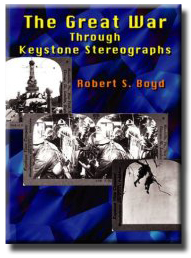
Robert S. Boyd: The Great War Through Keystone Stereographs
This really ought to go on the Collecting shelf, but it's about stereo photos so it's here anyway. I had hoped this would be like The Civil War in Depth, because the first world war was very well documented in stereo; but no such luck. This is a reference book for collecting stereophraphs on the subject from a single company. Keystone was one of the major US vendors (along with Underwood & Underwood) of stereo views. So if you're a collector of World War I views, this would be indespensible. For me it's a curiosity but a huge disappointment.
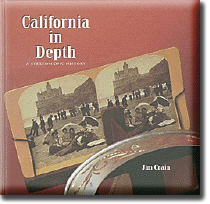
Jim Crain: California in Depth
I love in the "In Depth" series (see The Civil War in Depth below), even though it appears they quit with only three. Jim Crain is a stereograph enthusiast who opens his collection of photos from California's 19th century. This was fertile ground for the photographers of the period: there was a major port city (San Francisco), "the old west," the Gold Rush, strip mining, Yosemite, Tahoe, cavalry and indians. It's the age of Stanford, Muir, Twain and Bret Harte. Photos here are presented in pairs with a very nice viewer tucked into the back cover (be sure your copy of the book has the viewer before you buy). The reproductions are great and the stereo separation works very well.
I was particuarly interested in the Sacramento flood photos from the 1860s, since I lived there and I've seen the excavations of "Old Town," which had to be raised because the floods were so devastating.
Great stuff. It's sad the book is long out of print, but the good news is you can likely get it cheap from Amazon's used book service (or equivalent). Just make sure you get the viewer.
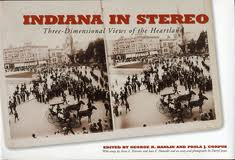
George R. Hanlin and Paula J. Corpuz: Indiana in Stereo
To look at this you'd think it was the companion to Iowa Stereographs, but no. Yet they're so similar I'm going to say the same thing about it: this is one of my favorite books of stereo views. The authors collected all kinds of views of Indiana and produced them full-size, in pairs (along with a little viewer). Images are both rural and urban, interiors and exteriors, and people and places. In addition to the many views there are lots of comments, commentary and quotes. It's partly a book about Iowa, partly about stereo photography, mainly about a time gone on both sides of the lens.
I recommend both Iowa Stereographs and this one very highly.
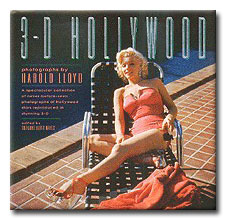
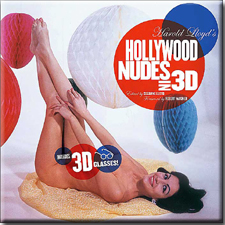
Harold Lloyd: 3-D Hollywood and Hollywood Nudes in 3-D
Many celebrities found themselves comfortable on either side of the camera—Yul Brynner, Jill St. John, Roddy McDowall, Linda McCartney, to name a few. Silent film star Harold Lloyd (most famous for hanging from a tilting clock tower by one hand in "Safety Last") was among them—using a Stereo Realist.
In the early 1950's, stereo photography enjoyed a small renaissance when the Stereo Realist came out—a 35mm format camera that easily made half-frame stereo pairs of slides that could be viewed with a hand-held viewer (rather like a Viewmaster) or projected using polarized lenses (just like in the movies). Lloyd was a serious hobbyist, and his granddaughter Suzanne Lloyd Haynes was kind enough to edit some of his images into these books.
The images in 3-D Hollywood are printed in high quality full color stereo pairs, one set per page, and a simple viewer is included— though the book can be enjoyed in 2D as well.
There are a few photos of the grounds of the magnificent Lloyd estate, "Greenacres," but most of the images are of people—friends, family and famous faces of the times. Marilyn Monroe is definitely the star of the volume—she appears many times in various outfits, including a sheer red negligee, but there are plenty of others as well: Richard Powell (sporting his own Realist), Candice Bergen (whose father Edgar, the legendary ventrilouquist, was also a stereographer), Jayne Mansfield, a very young Dorothy Provine (I miss her), Hedda Hopper, Alan Ladd (circa Shane), Howard Hughes and General Douglas MacArthur.
While many of the images are posed glamour shots (e.g. Marilyn, Dorothy and a great self-portrait of Harold himself), most of the rest are candids—images taken of guests or during Lloyd's travels. The small size of the images detract from them as fine-art, but they have that personal touch of snapshots—the kind of photo that's unposed and unrehearsed, yet the subject is very aware of the camera. But while they have that amateur's look, the sharpness, the color, the lighting and the attention to composition are a cut above, and the stereo effect is gravy.
Hollywood Nudes takes a difference course. All of the images here are nudes, and instead of stereo pairs, the book is divided between straight color prints of single images and two-color anaglyphs which need to be viewed with the provided viewer. The images are all girls, all nudes. They're not figure studies, but mildly erotic nudes, very much like the images Playboy printed in the 1950s in content and poses. They're tasteful nudes (moreso by modern standards than in his own era), and some are excellent by any standard.
It's Hollywood, so many of the models are young actresses who either wanted the attention or supplimented their incomes by modelling on the side. Most are long forgotten by now, but a few famous names pop up. Marilyn (did anyone not photograph her in the buff) Monroe shows up, as does Bettie Page.
I was pleasantly surprised with the text, which had a sense of fun and storytelling that's missing in most collections. I never knew him, but I like to think it's the book Harold Lloyd himself would have written if he'd tried.
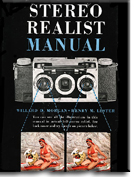 Willard Morgan & Henry Lester: The Stereo Realist Manual
Willard Morgan & Henry Lester: The Stereo Realist Manual
The David White's Stereo Realist was the camera that started the 3-D fad of the 1950s, and it was considered among the best. This book by Morgan & Lester wrote and edited this as part of their series of books on cameras and photography (such as Graphic Graflex Photography). It's not just a glorified camera manual, it's a survey of techniques that applies to all Realist-format cameras and stereo photography in general.
Morgan & Lester got a number of stereographers to contribute to this volume, including some of the celebrities who were part of the hobby: Harold Lloyd wrote the introduction, Edger Bergan wrote the first chapter, historian Beaumont Newhall the last. Each chapter is a different subject and include "Lighting, Exposure and Color," "A Personal Approach to Technique and Composition," "Portrait and Fashion," "Stereolusions," and "Stereo in Black and White."
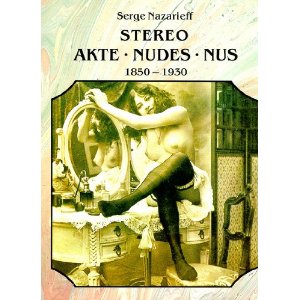 Serge Nazarieff : Stereo Nudes, 1850 - 1930
Serge Nazarieff : Stereo Nudes, 1850 - 1930
Physically this is one of the largest stereo books that I own; one of those that's written in 3 languages (English, French and German) presented side-by-side. But once the introduction is over, it's all photographs.
These are large-size reproductions of Holmes-format stereo pairs. Each page typically has two sets (toward the end there are often three), but sometimes a single will be reproduced to break up the visual monotony. All the images are printed in color, even though the originals would be in monochrome, which preserves tints, hand-coloring, and weathering.
At 153 pages it may seem slim, but there are a lot of photos. Unlike Peepshow or Hollywood Nudes, which are primarily cheesecake, these pairs run the gamut from artistic nudes to erotic nudes to fetish porn, so be warned that you may not want to leave this on the coffeetable if you're not sure about who may pick it up.
Unlike most of the books here, this one has a separate viewer and now pocket or provision to keep it with the book; mine is floating around somewhere in the bookcase, but a normal hand-viewer from another book should suffice.
Albert E. Osborne: The Stereograph and The Stereoscope
My copy is a small, slim hard-bound edition with no dust-jacket, so there's no point scanning the cover. The book is from 1909 and I doubt it was reprinted; you'll probably need to go through an antiquarian bookseller to find it. Some day I plan to scan and OCR the text for Project Gutenberg, but right now I'm afraid of breaking the spine.
This little book was published by one of America's big stereo companies, Underwood & Underwood, as a glorified sales brochure. It's cynical but I don't know how one could reach a different conclusion, because it's all about why photographs in general, and stereo views in particular, are so wonderful.
The fun part for me was seeing how it unfolded, and how the author milked it to get nearly 300 pages out of the subject. There are no plates, only a few line diagrams, no charts or tables. Instead it's a long essay that covers a huge amount of territory. Here are the chapter titles to give you a sense of it:
Introduction. Different ends for which pictures have been used. Different kinds of pictures. Stereographs and the stereoscope. Experiences of travel with stereographs. The importance of environment. The limitations of language. The wide environment the stereograph travel system gives. What are the necessities of life? Life is the purpose of our existence here. What is the life we are here to develop? Happiness vs. Pleasure. The different needs of our life. The fundamental conditions for the development of the intellect. The fundamental conditions for the development of the aesthetic nature. Fundamental conditions for the development of the moral nature. Fundamental conditions for the development of the religious life. The beautiful. The grounds of relgious belief. Differences in the quality of pleasures and the apparent conflict in life. Do good impulses always count?
Which boils down to looking at stereo views is good, wholesome, and intellectually and morally stimulating no matter what the preacher says.
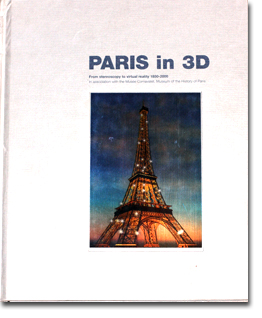 Paris in 3D: From Stereoscopy to Virtual Reality 1850-2000
Paris in 3D: From Stereoscopy to Virtual Reality 1850-2000
For me, Paris is everything that's pretentious, oversold, over-photographed, and done in the world. But this book, Paris in 3D, is the biggest and baddest in my collection. Produced by the Museum of History of Paris, it tries and succeeds at being a full-spectrum look at stereo photography from the beginning of time to date (or at least the year 2000, which is still close enough).
That said, this book is incredible. It tries to offer as much 3-D anything as possible. The cover photo is lenticular. Inside the back cover is the pouch with the viewers, just like many other books, except this one has three: a set with lenses for regular pairs, another with red/blue filters for anaglyphs, and a third with (I believe) polarized filters.
The book is heavily illustrated with stereo pairs, anaglyphs, photographs, drawings, you name it, it's in there in one form or another. The book covers the history of stereography, so there's a huge range of stuff to look at. Warning to people who are sensitive to this: there are nudes and a couple examples of stereo pornography.
It's a hell of a book. Pricey but worth it if you're interested in the subject.
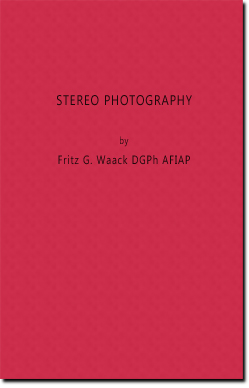 Fritz G. Waack: Stereo Photography
Fritz G. Waack: Stereo Photography
This is a pamphlet-style book that was available in the mid-80s from the now-defunct Reel 3-D Enterprises, though it's still available on Amazon and other used-book sources.
This is largely a technical book on stereo photography; there are no photographs, pairs or otherwise, but there are plenty of diagrams. It's a serious exploration into the how-to of making stereo images, particularly if you're using a single camera and making your own pairs from scratch. The text is dry and the whole thing looks intimidating, but there is a lot of good information in here if you're willing to read it.
Streoscopy.com has selections from the book available on their website in HTML form, so if you want to see what you're in for, take a look here first.
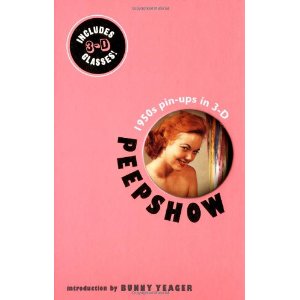 Bunny Yeager (intro): Peepshow - 1950s Pin-ups in 3-D
Bunny Yeager (intro): Peepshow - 1950s Pin-ups in 3-D
Bunny Yeager was a cheesecake model turned photographer who specialized in cheesecake and erotic (but tasteful) nudes; her heyday was the 1950s, and along with Peter Gowland she was a minor celebrity photographer. Yeager only wrote the introduction and the photos are uncredited, but they're in her style.
This book is small, about the size of a typical papeback, but it's hardbound and the stereo viewer is bound into the folding front cover, just like the Blum nature books above. The images are presented as pairs. The physical size of the book (and thus the viewer) requires the images to be small—just a bit larger than Realist format, but that adds something to the "peep" aspect of the book.
I enjoy it, I think it's a fun book. The nudes are the kinds of things that ran in Playboy, nudie playing cards, and the mass-market nudie magazines of the day; no pubic hair, no bizarre poses, the models usually smiling and looking like this is this is the most fun they've had in a week. The photos are colorful, the 3-D effect is strong, and it's well-done all-around.
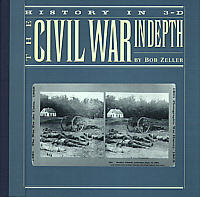
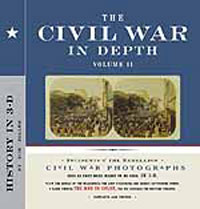 Bob Zeller: The Civil War in Depth, Volumes I and II
Bob Zeller: The Civil War in Depth, Volumes I and II
Stereo photography is nearly as old as photography itself. Charles Wheatstone explained the concept of stereoscopic vision right about the time that Daguerre began producing photographs. David Brewster created the first device for viewing stereo photographic pairs in 1849. By the time the American Civil War broke out in 1860, many photographers were making stereo pairs.
The advantage of shooting in pairs is that together you get a stereo image. But if you don't want a stereo image, you still have two perfectly good conventional images. Plus if one image was spoiled for some reason, they still had the other to sell.
Yet this is the first book of its kind—a collection of civil war photographs presented as stereo pairs, as the photographers intended (a folding viewer tucks into a pocket in the back cover). Some are by the most famous photographer of the era, Matthew Brady (or at least by his employees). There are several pairs of Lincoln, including the one that would later be used on the obverse of the penny, and the famous "last" image of Lincoln, taken just 10 weeks before his assassination. Also included are photographs of locations, equipment, men, and the aftermath of battle. And even though they're in black and white and the tonal fidelity is less than what we'd expect today (either too contrasty or too murky), some of the images are still clear enough to be disturbing.
There's also lucid text to put the images in perspective, with some comments on what the photographers had to go through to get them. And interesting captions to most of the images. The book is extremely well laid out and presented.
I would recommend this to anyone interested in the civil war era, regardless of whether they have an interest in stereo photography or not. It's that good a book.
Previous shelf: Portfolios and Photograph Collections